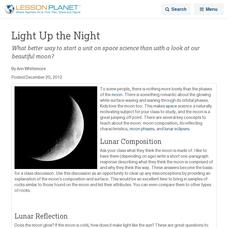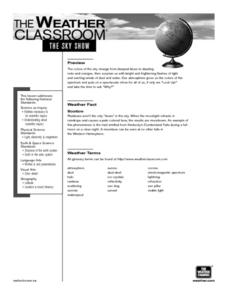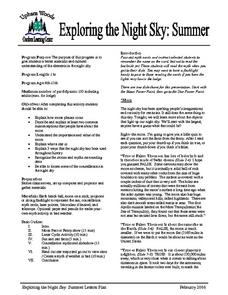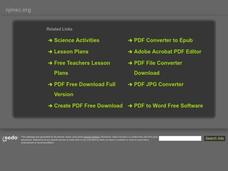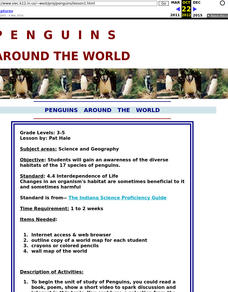Curated OER
How Bright are the Stars?
Students observe the brightness of stars and are introduced to the concept of apparent brightness as a measure of how much light hits a detector of a surface area during a given time. In this star lesson, students make connections...
NASA
Blinded by the Light!
Pupils learn of multiple ways astronomers look for planets outside of the solar system. By completing a hands-on activity, scholars discover that trying to see the planets directly because of the glare from the nearby star is nearly...
Reading Is Fundamental
Summer Fun...
Extend learning through summer with these activity ideas! Individuals can choose one or all nine of the activities, which range from a summer reading goal to an examination of local insects (with accompanying story prompt). See the...
Curated OER
Excite the Night with a Look at the Moon
What better way to start a unit on space science than with a look at our beautiful moon?
Global Change
Impact of a Changing Climate on the Pacific Walrus
How many of us can say they've seen a Pacific walrus? Not many and one of the reasons is the impact of climate change on their aquatic environment. Children get to think about the food web of the Bering Sea by creating an actual web with...
Curated OER
Star Light, Star Bright: Exploring How Stars are Classified
In this star classification activity, middle schoolers are given laminated star charts to make observations about stars. They work in groups to classify groups of stars based on different characteristics. For each group of stars they...
Big Kid Science
Create a Milk Carton Camera to Observe the Eclipse!
Step aside, fancy glasses... it's time to create a solar eclipse viewing camera of your own using nothing more than a milk carton.
Curated OER
Sky Show
Students participate in a discussion of the sky and colors. They watch a demonstration of how colors can change. They examine the issue of if weather should be a part of their coursework.
GoSoftWorks
GoSkyWatch Planetarium for iPad - The Astronomy Star Guide
Digital compass alignment enables navigation of the skies with true orientation at any time. Just point to the sky or "aim for the stars!" This application acts as a virtual telescope, allowing you to zoom in on any object that is...
Curated OER
Classify Animals
Give your class an idea of how animals are classified by scientists with this interactive PowerPoint activity. They are presented with six different animals, they answer yes or no questions until only one animal remains alongside...
Space Awareness
Star in a Box
What happens to stars as they get older? A simulation takes pupils through the life cycle of stars based on their masses. The resource introduces the Hertzsprung-Russell diagram and the common relationships and life cycle patterns observed.
Curated OER
Butterflies
In this science and reading comprehension worksheet, students read a 1 page detailed passage about butterflies. Students then answer 7 questions.
Curated OER
Exploring the Night Sky: Summer
Learners explain how moon phases occur. They describe and explain at least two common misconceptions that people have about the moon. Students explain what a star is. They explain 3 ways that the night sky has been used throughout history.
Curated OER
Phases of the Moon
In this moon phases worksheet, students learn about the different phases that the moon goes through. They then use the information the learned to answer the 9 questions in the packet. The answers are on the last page.
Curated OER
Classification and Identification
Students, after exploring and analyzing diagrammatic and taxonomic keys and their association to marine sciences, identify and classify objects and organisms based on visual attributes/characteristics. They research and create their own...
Curated OER
Specific Heat
In this specific heat worksheet, students read about the amount of heat needed to raise the temperature of a substance. They are given the equation for calculating joules and they solve four problems using the equation.
Curated OER
Penguins Around the World
Students gain an awareness of the diverse habitats of the 17 species of penguins. Standard: 4.4 Interdependence of Life Changes in an organism's habitat are sometimes beneficial to it and sometimes harmful.
Curated OER
The Heat is On!
Fifth graders investigate evidence for changes in matter that occur during a chemical reaction.
Curated OER
Our Five Senses
Young scholars use their five senses to describe what's in a mystery bag. In this senses lesson, students use a graphic organizer to collect words for a sensory poem.
Curated OER
What is the Nucleus Like?
In this nucleus of an atom instructional activity, high schoolers answer 19 multiple choice questions about the structure of the atom, radioactive decay, isotopes and half life.
Curated OER
Classroom Animals & Pets - Insects & Company - Butterflies
Young scholars examine the life cycle of a butterfly. They place caterpillars in a cage and observe their change to a butterfly. Students discover how much a caterpillar eats and annotate growth information.
Curated OER
The Hinode Satellite Views the Sun
In this sun's magnetic field lines worksheet, students use a photograph taken by the Hinode Satellite that shows the complex magnetic structure of the sun over a sunspot. Student predict the magnetic field lines and draw them on a...
Curated OER
Exploring the Night Sky: Fall/Winter
Students explain how moon phases occur. They explain three ways that the night sky has been used through history. Students locate some of the constellations in the night sky. They discuss stories and myths surrounding stars.
Curated OER
Activity #18 Decompostion of Baking Soda
Students observe what occurs as baking soda is heated. They explain why a chemical rather than a physical change occurred during the procedure. Pupils identify the tpe of reaction (decomposition). Students conduct a glowing splint...



